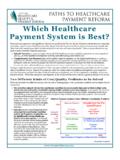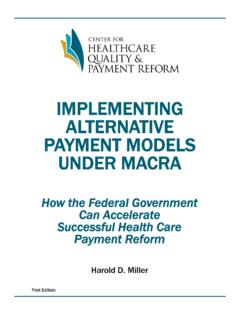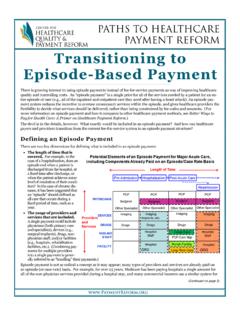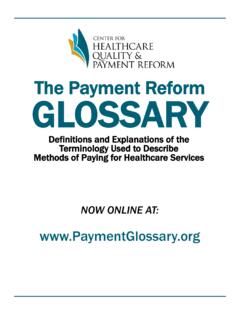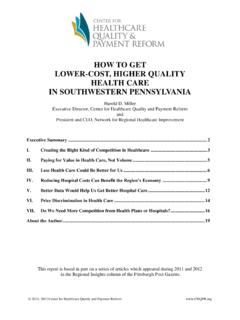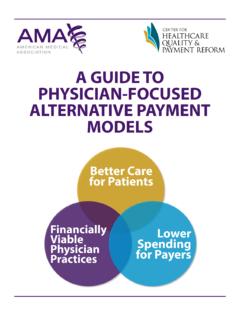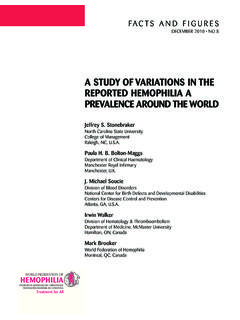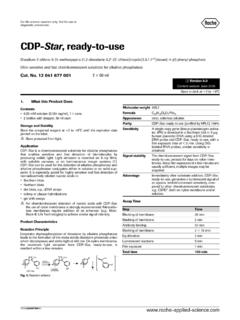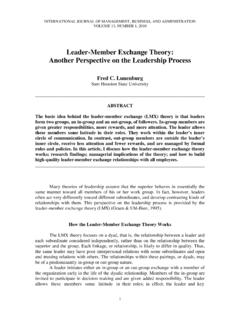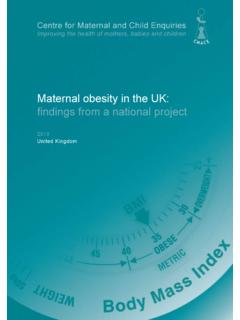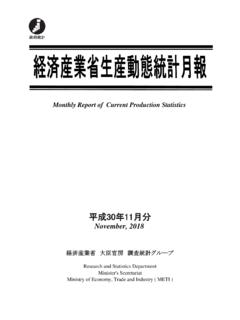Transcription of PRHI Readmission Briefs - Payment Reform
1 prhi Readmission Briefs Brief 1: Overview of Six Target Chronic Diseases INTRODUCTION. As healthcare costs consume more and more of American resources, driven in large measure by the growing burden of chronic disease, both policy proposals and demonstration projects are exploring ways to improve care and to reduce costs. In many of these efforts, hospital Readmission rates have become an important measure of both quality and costs. Not only are Readmission rates extraordinarily high (in a recently-published estimate,1 of Medicare beneficiaries were readmitted within 30 days of discharge, resulting in $15 billion in spending annually), but between 10% and 50% of readmissions are considered to be potentially Lastly, 30-day Readmission rates have become important hospital financial metrics, as payors most notably Medicare are increasingly denying coverage without detailed medical justification for the Readmission . Using a Readmission rate as a quality or cost measure, however, is not without shortcomings.
2 There are numerous questions, for example, about the positive and negative impact on provider behavior of rewarding, penalizing and/or publishing Readmission rates. The need for more information about the nature and characteristic of hospital readmissions is clear. The prhi Readmission Briefs aim to add clarity to the debate by developing a series of reports that focus on the following questions: Centre City Tower 1. What is the right time frame for defining a potentially avoidable Readmission ? For how many 650 Smithfield St. days past discharge is a Readmission potentially preventable, and how does this vary by condition? Suite 2400. 2. To what extent are readmissions likely to be related to an initial admission and to what extent does Pittsburgh, PA 15222. this vary across diagnoses? Ph: 412-586-6700. Fax: 412-586-6701 3. To what extent are readmissions within the domain of hospital control? 4. Are there patterns of admissions and readmissions that can help clinicians flag, and then prevent, unnecessary hospitalizations?
3 Readmission Brief I begins with a comparative overview of admissions and readmissions to acute care By: hospitals in Southwestern Pennsylvania (SWPA) of patients with six key chronic conditions, between Keith Kanel, MD October 2007 and September 2008. Subsequent Briefs will focus in greater depth on specific chronic Susan Elster, PhD conditions, adding more detailed analyses about characteristics of both admissions and patients, including Colleen Vrbin number of days between discharge and Readmission , length of stay and hospital charges, as well as detailed analyses of diagnoses, patient demographics, severity of condition, presence and number of specific co- morbidities (including behavioral health co-morbidities), and patterns of patient admission, discharge and Readmission over multiple hospitalizations. METHODS. The report draws on hospital admissions data collected by the Pennsylvania Health Care Cost Containment Council (PHC4),3 an independent agency created by the Pennsylvania Legislature in 1986 with the mandate to collect a wider range of inpatient data, irrespective of payer or PHC4 is one of the nation's more Unlike the comprehensive sources of all-payer, inpatient data.
4 The data for this study are drawn from a database of Dartmouth Atlas, 408,925 all-cause admissions to 44 acute care facilities in the 11-counties of Southwestern Pennsylvania (SWPA).5. the PHC4. database studied Admissions for patients with six target chronic conditions were identified using Medicare Severity all patients, not Diagnostic Related Groups (MS-DRGs), which replaced DRGs on October 1, 2007. Like DRGs, MS-DRGs just Medicare. classify the reason for a hospitalization based on a series of principal and secondary diagnoses as well as procedure codes. In addition, unlike DRGs, MS-DRGs incorporate severity of the patient condition with codes that mark the presence of complications and comorbidities. This adjustment allows for enhanced payments to hospitals that care for sicker patients within the same MS-DRG. Hospitalizations for patients with the following chronic conditions will be the focus of this inquiry. Pittsburgh Regional Health Initiative June 2010.
5 Chronic Condition Diagnostic Category Heart Failure MS-DRG 291-293. Chronic Obstructive Pulmonary Disease (COPD) MS-DRG 190-192. 6. Acute Myocardial Infarction (AMI) MS-DRG 280-285. Depression MS-DRG 881. Asthma MS-DRG 202-203. Diabetes MS-DRG 637-639. Readmission rates are defined as a discharge from, followed by an admission to an acute care hospital within a specified period of time, and are calculated after excluding from the denominator patients who died during the initial, or index admission. All analyses also exclude patients who were transferred on the day of discharge to another acute care hospital, children ages 18 years and younger, as well as admissions with missing age or principal diagnosis, missing or invalid discharge status, or a MS-DRG classification of 999 (diagnoses and/or procedures that are ungroupable ). We examine readmissions that occur within the 12 months of the available data, following the index admission. Finally, while the PHC4 data permit analyses of both admissions and patients (who may have had multiple admissions during the period), this report focuses exclusively on admissions.
6 In subsequent, disease-specific Briefs , both admissions and patients will be the subjects of inquiry. OVERVIEW OF ADMISSIONS AND READMISSIONS. The six target conditions account for more than 40,000 hospital admissions in SWPA in the study period. These admissions represent 10% of all admissions and 14% of all medical admissions7 and are among the 21 most common medical MS-DRG admissions (from the group of more than 350) in SWPA. Heart failure and COPD alone account for 9% of all medical admissions. Table 1. Overview of Targeted Chronic Disease Admissions in SWPA. Percent of Ranking Among Number of Percent of all Medical MS- Medical MS- Targeted Condition Admissions MS-DRGs DRGs DRGs*. Heart Failure 13,503 3% 5% 3. COPD 12,137 3% 4% 4. AMI 4,728 1% 2% 11. Depression 3,477 1% 1% 18. Asthma 3,392 1% 1% 19. Diabetes 3,029 1% 1% 21. Total 40,266 10% 14% - *The top 10 medical diagnoses in the PHC4 data set are, in ranked order: psychoses, normal childbirth, heart failure, COPD, digestive disorders, rehabilitation, septicemia, cellulitis, pneumonia, and chest pain.
7 As shown in Table 2, these six conditions also account for nearly 9,000, 30-day readmissions and 19,000. readmissions within the 12-month study period. All but asthma are in the top 20 reasons for readmissions One in 5 hospital among medical MS-DRGs. Readmission rates average 22% within 30 days almost the same as the discharges were average for all other medical MS-DRGs (21%) and similar to the that Jencks found using Medicare readmitted within a month. Pittsburgh Regional Health Initiative June 2010. Page 2. Table 2. Readmissions within 30 Days and within 12-Month Study Period 30-Day Readmissions Readmissions within 12 Months Ranking Ranking Among Among Readmit Medical Readmit Medical Targeted Condition Number Rate MS-DRGs Number Rate MS-DRGs Heart Failure 3,392 26% 1 7,242 55% 1. COPD 2,716 23% 3 6,028 50% 3. AMI 1,010 23% 7 1,892 44% 8. Depression 640 18% 14 1,349 39% 17. Asthma 355 10% 32 1,058 31% 23. Diabetes 618 21% 16 1,351 45% 16. Total Targeted Conditions 8,731 22% - 18,920 47% - The economic costs associated with these admissions and readmissions are enormous.
8 Measured by hospital-provided charge data, these six conditions account for over $658 million in total charges (not actual payments), with heart failure alone accounting for nearly $247 million (Table 3). Table 3. Average Total Charges and Length of Stay (LOS). Six common Targeted Condition Average LOS Average Total Charge Total Charge chronic medical Heart Failure $ 18,266 $ 246,650,362. diseases incurred annual hospital COPD $ 15,196 $ 184,429,221. charges of nearly AMI $ 23,850 $ 112,760,806. $250 million in Depression $ 8,724 $ 30,334,163. southwestern Asthma $ 11,465 $ 38,888,219. Pennsylvania. Diabetes $ 14,855 $ 44,996,596. TIMEFRAME FOR DEFINING READMISSIONS. Readmissions may be defined using various time frames. As the clinical relevance for a 30-day Readmission is not always obvious, this section examines various timeframes for defining a Readmission . Of interest is not only when most patients return, but also the potential savings from avoiding Readmission within various timeframes.
9 Days to Readmission Figure 1. Figure 1 shows the distribution Days to Readmission Readmit 91-365 Days of all readmissions across three Readmit 31-90 Days periods of time: within 30 100%. Readmit 0-30 Days days, between 31 and 90 days, 21% 23% 21% 23% 23% 23%. and between 91 and 365 days. 80% 35%. The 30-day timeframe captures 32% 26%. 29% 32% 31%. 60% 32%. the largest share of 31%. readmissions for every 40%. condition except asthma. The 53% 47%. 20% 47% 45% 46% 46%. data confirm that readmissions 34%. occur disproportionately closer 0%. to the day of discharge, with an Heart COPD AMI Depression Asthma Diabetes All average of 46% across all six Failure Targeted Conditions conditions occurring in the first Source: prhi analysis of PHC4-provided discharges between Oct. 1, 2007-Sept. 30, 2008. 30 days, and nearly 80%. occurring within three months. The implication is that the first 30 days is the critical interval, and represents the greatest opportunity for improvement.
10 Pittsburgh Regional Health Initiative June 2010. Page 3. POTENTIALLY PREVENTABLE READMISSIONS. It is estimated that 10% of readmissions are scheduled a figure we accept as Understanding what readmissions among the remaining 90% are potentially preventable requires, as an initial step, an assessment of which admissions are related to one another. Recognizing that there are complex methods for establishing such relationships,10 we, nevertheless, begin by identifying: (1) readmissions with the same MS-DRG as the index admission; and (2) readmissions for PHC4-defined complications or infections. Reasons for Readmission This section assumes that sequential admissions with the same diagnosis are more likely to be related to one another, and that some of these are likely to be unplanned and potentially preventable. For our purposes, a Readmission was considered related to an index admission if any of the MS-DRG codes defining the condition were present on both. For example, COPD is defined using MS-DRG codes of 190- 192; a Readmission with MS-DRG 190 is considered related to an index admission with MS-DRG 191.
